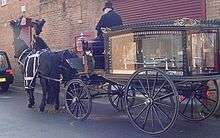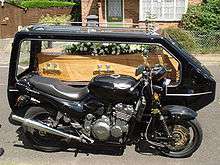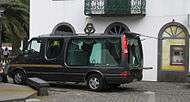Hearse

A hearse is a funeral vehicle used to carry a coffin/casket/urn from a church or funeral home to a cemetery. In the funeral trade, hearses are often called funeral coaches.
History

Originally considered public transportation, an elaborate framework would be erected over a coffin or tomb to which memorial verses or epitaphs were attached. It was then put on the top of horse-drawn carriages, looking much like a luggage rack. Today, the original hearse remains acknowledged by the bit of scroll work or stretched-out "S" on the side of a funeral coach, called Landau bars.
Hearses were originally horse-drawn, but silent electric motorized carts were introduced as horses began to be phased out as transportation. Examples that were used in Paris were reported in the pages of Scientific American May 1907 and petrol-driven hearses began to be produced from 1909 in the United States. Motorized hearses became more widely accepted in the 1920s. The vast majority of hearses since then have been based on larger, more powerful car chassis, generally retaining the front end up to and possibly including the front doors but with custom bodywork to the rear to contain the coffin. Some early hearses also served as ambulances, owing to the large cargo capacity in the rear of the vehicle. A few cities experimented with funeral trolley cars and/or subway cars to carry both the casket and mourners to cemeteries, but these were not popular. The only exception was Chicago, Illinois which operated 3 different funeral trolley cars over the elevated tracks in downtown Chicago to outlying cemeteries in the western suburbs. A special funeral bureau handled the funeral trains which sometimes operated 3–4 funeral trains a week over the 'L'.
North America and Europe
Usually more luxurious automobile brands are used as a base for funeral cars; the vast majority of hearses in the United States and Canada are Cadillacs, and less frequently, Lincolns. In Europe, Mercedes-Benz, Daimler, Jaguar, Opel, Ford, Vauxhall Motors and Volvo are or were common contemporary bases, and in the past even used Rolls-Royce cars were converted, though their cost is generally considered prohibitive.
Cadillac produced what it termed a "commercial chassis". This was a longer and strengthened version of the long-wheelbase Fleetwood limousine frame to carry the extra weight of bodywork, rear deck and cargo. Designed for professional car use, the rear of the Cadillac commercial chassis was considerably lower than the passenger car frame, thereby lowering the rear deck height as well for ease of loading and unloading. They were shipped as incomplete cars to coachbuilders for final assembly. A Cadillac commercial chassis typically consisted of the car's front end sheet metal with lighting and trim, dashboard and controls. Rear quarter panels and sometimes the front door shells were shipped with the chassis for use in the finished coachwork. Today, most hearses are made from converted sedans on stretched wheelbases. The fleet division of Ford Motor Company sells a Lincoln Town Car with a special "hearse package" strictly to coachbuilders. Shipped without rear seat, rear interior trim, rear window or decklid, the hearse package also features a heavy-duty suspension, brakes, charging system and tires and was once offered on a modified Ford Expedition SUV chassis with the Triton V10 truck engine.
Hearses and other funeral service vehicles in the U.S. are often equipped with purple or orange light bars and other flashing lights similar to those found in emergency vehicles in order to increase the visibility of the vehicle while in processions.
In Europe, most hearses are based on commercial vans. In the past, all medium-sized vans could be converted into hearses. Today, Mercedes-Benz vans are common in modern fleets. It is common to keep old fleets since they have little wear.
Since the working life of a hearse is generally one of light duty and short, sedate drives, hearses often remain serviceable for a long time; hearses 30 years old or more may still be in service, although some funeral directors replace them once, or twice a decade. As of 2004, a new hearse in the USA usually costs in the range of $60,000 to $85,000.

Two styles of hearse bodywork are common. The older style is the limousine style; these have narrow pillars and lots of glass. These are more popular in the United Kingdom, among others. More popular in the United States is the landau style, with a heavily-padded leather or (later) vinyl roof, and long blind rear quarters, similarly covered, and decorated with large metal S-shaped bars designed to resemble those used to lower the tops on some horse-drawn coaches. It is common practice in the USA for the windows to be curtained, while in the UK the windows are normally left unobscured. Hearses resemble station wagons strictly because of the shape of the rear ends of conventional ones.
Until the late 1970s, it was common for hearses in the USA to be combination coaches which also could serve in the ambulance role; these were common in rural areas. Car-based ambulances and combination coaches were unable to meet stricter Federal specifications for such vehicles and were discontinued after 1979.
Due to the costs of owning an expensive custom vehicle that sits idle "80 to 90 percent of the week", individual funeral homes reduce costs by renting or utilizing a shared motor pool.[1][2]
Japan
In Japan, hearses, called reikyūsha (霊柩車), can come in two styles: "Foreign" style, which is similar in build and style to an American hearse, or a "Japanese" style, in which the rear area of the vehicle is modified to resemble a small, ornate Buddhist temple. This generally requires the rear of the vehicle to be extensively altered; commonly, the rear roof is cut away from the front windows back and all interior parts are removed from the rear as well. The ornate Buddhist-style rear area, generally constructed of wood and in which the casket or urn is placed, is built on top of this empty cavity and most often is wider than the base of the vehicle, so that it sticks out on the sides, over the rear body panels. Popular bases for these are not limited to large sedans, but also minivans and even pickup trucks by companies like Nissan and Toyota.
There are regional differences of ornaments. Nagoya style decorates not only the upper half of the body, but the lower half as well.[3] Kansai style has a relatively modest decorations unpainted.[4] Kanazawa style is known for having a red body (other styles mostly have black bodies) with gilded ornaments.[5] Tokyo style, found anywhere else in Japan, features painted/gilded ornaments on the upper half of the body.[6]
"Foreign" style hearses are mostly similar in appearance to their US counterparts, although their exterior dimensions and interiors reflect the Japanese preference for smaller, less ornate caskets (this in light of the national preference for cremation). This means that, in contrast to American hearses, the rear quarter panels require less, and sometimes no, alteration. These are generally built from station wagons such as the Nissan Stagea, or from executive sedans such as the Toyota Celsior (Lexus LS in the US) and Nissan Cima (Infiniti Q45 in the US). Interestingly, American market vehicles such as the Lincoln Town Car and Cadillac DeVille, which are otherwise fairly uncommon in Japan, are often converted to hearses in both styles.
Hong Kong
In Hong Kong, light goods vehicles of Isuzu, Volkswagen and Ford are used as hearses by most of the privately operated funeral homes.[7][8][9]
Others

The motorcycle hearse has become popular and is often used during the funeral of motorcycle enthusiasts.[10] This type of hearse is either a motorcycle with a special sidecar built to carry a casket or an urn at the side of the rider, or it is a trike that carries the casket behind the rider.
In recent decades, high capacity funeral homes have implemented designated "first-call" vehicles, used exclusively to transport the deceased to the funeral home. These vehicles are often converted full-size station wagons that may or may not feature a traditional landau roof and bars, although in recent years, following the end of the full-size station wagon era, the preference has shifted towards minivans or sport utility vehicles with slide-over landau bar panels for the third row windows. Many first-call vehicles have the appearance of a hearse, but will not accommodate a full-sized casket in length or height. The blue Mercury in the gallery is a retired first-call vehicle (?).
Perhaps owing to the morbid nature of the hearse, its luxurious accommodations for the driver, or both, the hearse has a number of enthusiasts who own and drive retired hearses. There are several hearse clubs.[11]
Amongst enthusiasts, the 1959 Cadillac Miller-Meteor hearse is considered one of the most desirable due to its especially ornate styling and appearances in feature films, notably an ambulance version (Ecto-1) in the motion picture Ghostbusters.
In the 1971 film Harold and Maude the character Harold, played by Bud Cort, drives two hearses: originally a 1959 Cadillac Superior 3-way; and then later a custom hearse he makes from a 1971 Jaguar XK-E 4.2 Series II. The Cadillac hearse is now privately owned in central California and is preserved, looking essentially identical to the way it did in the film. Only one Jaguar "hearse" was built and was destroyed as part of the film's storyline. Several Harold and Maude fans have since built similar hearses from E-Types and photos of them can be found online. Jane Goldman, wife of British TV and radio personality Jonathan Ross, owns a similar style "hearse" built from a Jaguar XK8 convertible.
The Rogues prowl around in a graffitied 1955 Cadillac Hearse in the cult classic film The Warriors.[12]
Celebrity hearse enthusiasts include rock singer Neil Young and three-time NASCAR Sprint Cup Champion Tony Stewart, who had his hearse customised for a television show. Sam the Sham of the Pharaohs (known for Wooly Bully and Lil' Red Riding Hood) was known for transporting all his equipment in a 1952 Packard hearse.
In the HBO television show Six Feet Under, which dealt with death every week, premieres with the Fisher family patriarch Nathaniel, a funeral director, killed in an accident involving his new hearse. His daughter Claire also owned and drove a hearse. In the popular Canadian television program Degrassi, character Eli Goldsworthy, a 'death obsessed' 16-year-old, drives a 1960s era vintage hearse, affectionately nicknamed Morty. Cleve Hall, of the Syfy television show Monster Man, drives a 1980 Superior, with added coach lights on each side, in the 1st season of the show. He now drives a 1963 Miller Meteor named "Lucy".
In Singapore, the grand hearse is built with a lorry chassis.
Images
.jpg) A horse-drawn hearse with driver, Scranton PA circa 1900.
A horse-drawn hearse with driver, Scranton PA circa 1900.- Funeral carriage, Museum of Funeral Customs
- 1959 Cadillac hearse, Ypsilanti, Michigan
 A hearse from Volvo circa 1935
A hearse from Volvo circa 1935 Horse-drawn hearse pulled by two Lipizzaner stallions
Horse-drawn hearse pulled by two Lipizzaner stallions
 Kew cemetery's horse-drawn hearse at the Kew Festival, 2009
Kew cemetery's horse-drawn hearse at the Kew Festival, 2009


 Buddhist-Styled Hearse
Buddhist-Styled Hearse- Modern Australian 'dual-cab' Holden Caprice hearse
 Hearse Chrysler 300 In Santiago of Chile.
Hearse Chrysler 300 In Santiago of Chile. Chrysler Town And Country used as a hearse car in Santiago of Chile.
Chrysler Town And Country used as a hearse car in Santiago of Chile.
Other uses of the term
In the traditional Holy Week services of the Roman Catholic Church and some Anglican churches, a candelabrum with 15 candles on it is used for the service of Tenebrae. This candlestick is referred to as a "hearse".
See also
| Wikimedia Commons has media related to Hearse. |
- Bier
- Car body style
- Combination car
- First Call vehicle
- Flower car
- Funeral train
- The Hearse – A 1980 horror film
References
- ↑ Archived 31 August 2009 at the Wayback Machine.
- ↑ Providing advisory services to funeral directors from The CPA Journal
- ↑ 全国霊柩自動車協会 (Nagoya type hearse house type) from 09net.jp (Japanese)
- ↑ 全国霊柩自動車協会 (Kansai type hearse house type) from 09net.jp (Japanese)
- ↑ Archived 29 August 2009 at the Wayback Machine.
- ↑ 全国霊柩自動車協会 (Kanto type hearse house type) from 09net.jp (Japanese)
- ↑ http://big5.xinhuanet.com/gate/big5/news.xinhuanet.com/ent/2006-09/15/content_5094741.htm
- ↑ http://ent.163.com/06/0314/16/2C6H5EKD00031H2L.html
- ↑ http://hk.apple.nextmedia.com/news/art/20120426/16283092
- ↑ Bowden Pickstock, Susan (9 November 2006). "Has the world gone mad? A motorcycle hearse…?". BBC News. Retrieved 10 February 2012.
- ↑ "Other Hearse Clubs". Grim Rides. Retrieved 2012-12-26.
- ↑ http://www.v8tvshow.com/forum/index.php?action=printpage;topic=9768.0